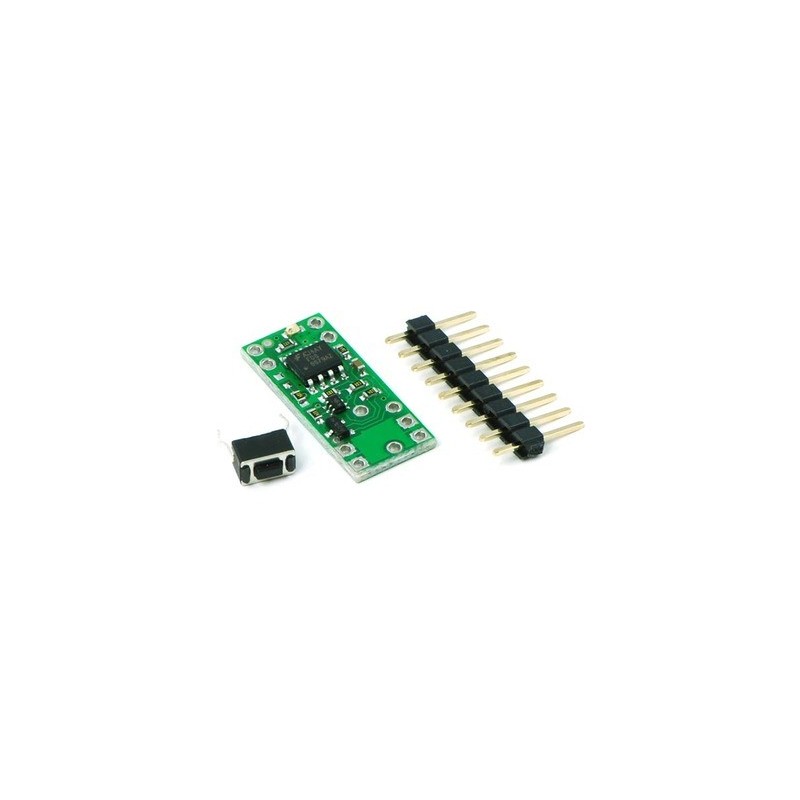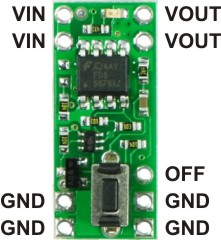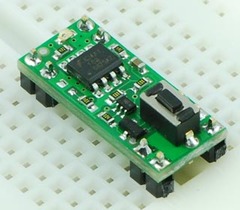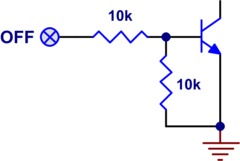- Out-of-Stock

Pololu Pushbutton Power Switch LV
The Pololu Pushbutton Power Switch is a patented design initially created for our Orangutan Robot Controllers as an alternative to bulky mechanical switches. The switch is intended to be the main power switch for a DC device requiring up to several amps of current. Please see the detailed description for product details and limitations. This item is the 2.5-7.0 V low-voltage version.
Note: The Pololu Pushbutton Power Switch is available in two voltage versions: standard voltage, 4.5-20 V and low voltage, 2.5-7.0 V. Please be sure to select the correct unit for your application.
 |
The Pololu Pushbutton Power Switch is a compact, solid-state power switch controlled by a momentary pushbutton switch. Because the switched current does not flow through the mechanical switch, a large variety of small, low-power switches can be used to control a substantial amount of power. The use of momentary pushbutton switches also allows multiple switches to be used in parallel to control the power to one load. The solid-state switch also allows the load to turn off its own power, which can be beneficial when used with battery chemistries sensitive to over-discharging. Please note that this switch has several drawbacks when compared to mechanical switches, so please be sure you fully understand this product before using it in your system.
The Pololu Pushbutton Power Switch works well in its intended application as a DC power switch for small robots, but because it is fundamentally different from a mechanical power switch, the benefits and drawbacks of the components must be fully considered.
Benefits over mechanical switches:
Drawbacks compared to mechanical switches:
 |
| Pololu Pushbutton Power Switch on a solderless breadboard. |
|---|
The Pololu Pushbutton Power Switch can fit in an 18-pin DIP (dual in-line package) footprint, making it compatible with solderless breadboards and perforated printed circuit boards with standard 0.1" spacing. For such applications, the included male header pins can be soldered to the switch PCB as shown in the picture to the right. Alternatively, wires can be soldered directly to the switch PCB for non-breadboard applications. For high-current applications, make sure that the wires can safely carry the current. Two pads/pins are provided for each of the power nodes, and multiple pads should be used for applications drawing over 5 A.
The included pushbutton switch can be used to trigger the switch. Alternatively, a separate pushbutton, such as a remote panel-mounted unit, can be used instead. Multiple pushbuttons can be wired in parallel for multiple control points, and each of the parallel pushbuttons will be able to turn the switch on or off. The latching circuit performs some button debouncing, but pushbuttons with excessive bouncing (several ms) might not function well with this product.
The Pololu Pushbutton Power Switch has two main components: a P-channel power MOSFET that switches the load current and a latching circuit that controls the gate of the MOSFET.
 |
| Pololu Pushbutton Power Switch block diagram. |
|---|
The overall switch performance is determined by the MOSFET characteristics, which are specified in their datasheets. The standard voltage version uses the FDS6679AZ (421k pdf); the low-voltage version uses the FDS4465 (141k pdf). The latching circuit is designed to operate over a wide range of voltages and to draw very little current in the off state (typically under 0.01 ěA). In the on state, the switch pulls the MOSFET gate to within 0.2 V of ground so that the MOSFET’s Vgs can be approximated as the supply voltage.
 |
| Pololu Pushbutton Power Switch OFF input detail. |
|---|
The latching circuit controlling the power MOSFET includes an OFF input that can be used by the target device to shut off its own power. The internal structure of this input is shown to the right. Applying more than approximately 1 V to the OFF pin will cause the power switch to turn off. The maximum voltage for the OFF pin is 30 V independent of the switch voltage (VIN).
The switch operating range is limited by the ability to change state reliably. At low voltages, the switch is difficult to turn on, and the switch will turn itself off once the voltage falls far enough (typically 3 V and 1.5 V for the SV and LV versions, respectively). At high voltages, the switches become difficult to turn off. The reliability of turning off is affected by a combination of the supply voltage, the amount of bouncing on the pushbutton switch, and the amount of noise on the supply line. For applications at the high end of the operating range, tests should be performed to ensure that the device can properly turn off.
 |
Pololu 5V Boost Regulator NCP1402 |
 |
Pololu Pushbutton Power Switch SV |
 |
Pololu Adjustable Boost Regulator 2.5-9.5V |
Manufacturer BTC Korporacja sp. z o. o. Lwowska 5 05-120 Legionowo Poland sprzedaz@kamami.pl 22 767 36 20
Responsible person BTC Korporacja sp. z o. o. Lwowska 5 05-120 Legionowo Poland sprzedaz@kamami.pl 22 767 36 20
No product available!
Module with 4-channel DC motor driver (2 x TB6612FNG) designed for FireBeetle boards. It communicates via the I2C interface. DFRobot DFR0508
No product available!
No product available!
No product available!
No product available!
No product available!
BleBox SaunaBox Pro is a modern sauna controller that provides remote temperature control, a control panel, and advanced operation schedules. Equipped with an external antenna, it is perfect for outdoor garden saunas, offering extended WiFi range and full control from anywhere in the world
No product available!
No product available!
A highly cost-effective audio hat which fits on the GPIO of the Raspberry Pi B+/2B/3B, uses i2S interface audio solution, supports 24-bit /192KHz high quality sound, compatible with other audio equipment via RCA lotus socket, includes a built-in high fidelity headphone amplifier, where you can plug in a 3.5mm audio jack directly. DFR0449
No product available!
The thrill of speed, roar of engines, wheel to wheel battles and shiny frames flashing before the eyes of wildly excited audience of the early car races – it’s all there, in UGEARS’ fascinating U-9 Grand Prix Car based on iconic designs of the Golden Age of the automobile industry at the beginning of the XX century. UGears 70044
No product available!
No product available!
Integrated, built-in SOM (System on Module) ARM system, equipped with TI AM3354 processor with ARM Cortex-A8 core, 512 MB DDR3 SDRAM, 512 MB Nand Flash and Gigabit Ethernet PHY and interfaces supporting PRU / ICSS protocols in real time. MYiR MYC-AM3354
No product available!
No product available!
No product available!
No product available!
The contactless temperature meter operates in the temperature range from - 18ºC to +400 ºC. The measurement is triggered by a trigger, and the built-in laser pointer makes it easy to aim at the object. A clear display is used to read measured data. UNI-T UT300C
No product available!

Pololu Pushbutton Power Switch LV
